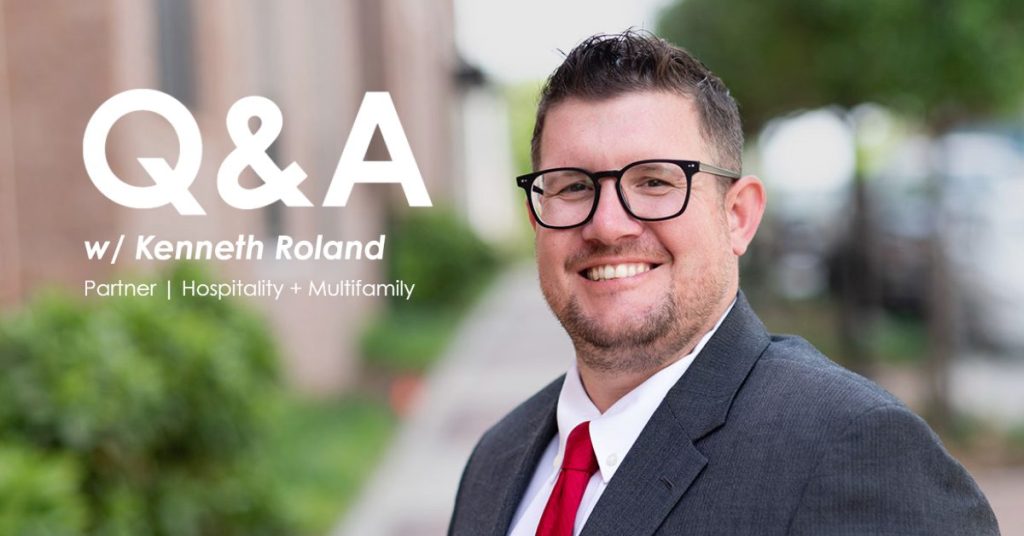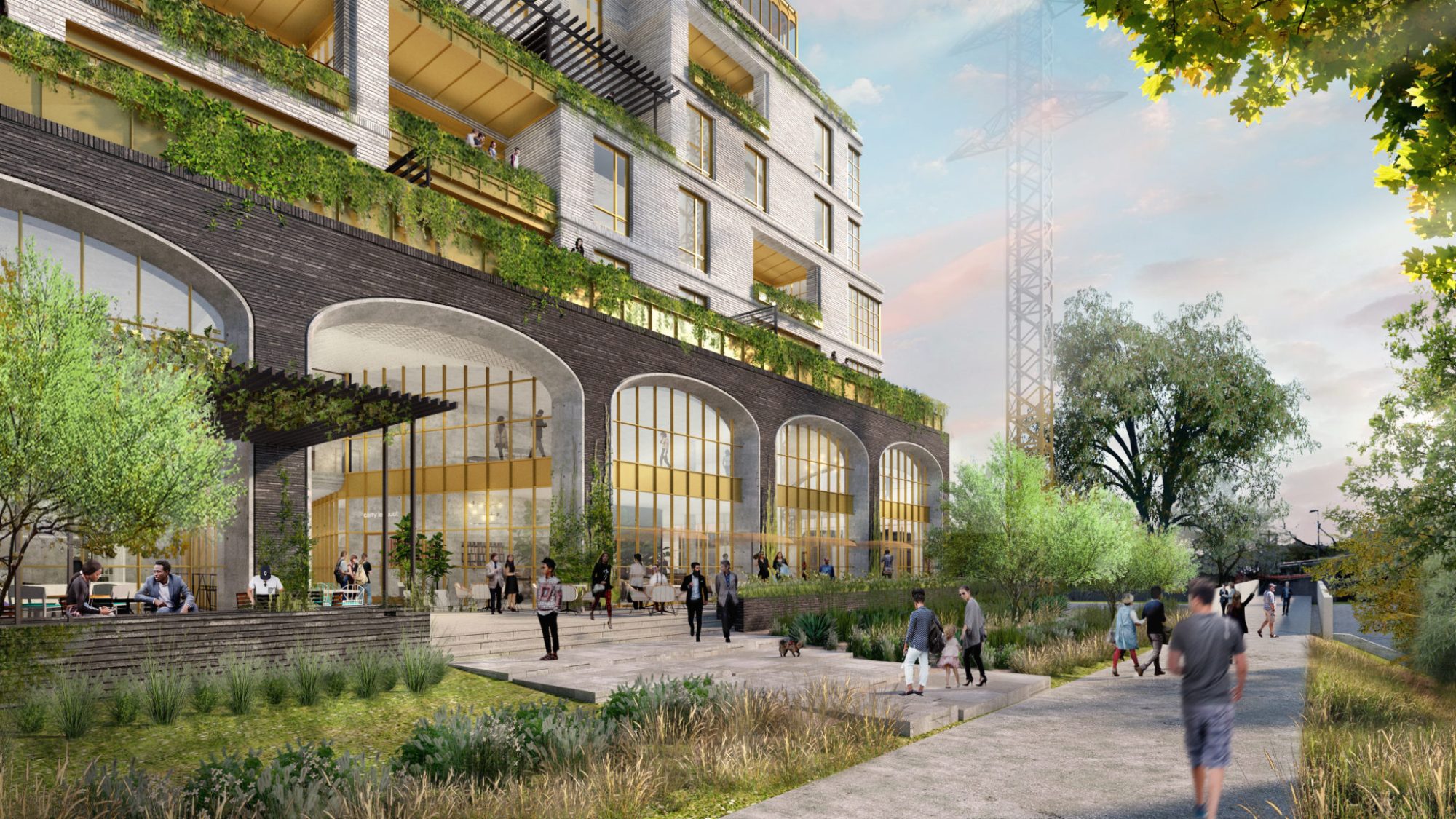
Kenneth (Kenny) Roland, PE serves as a Partner in DBR’s Dallas office and has been with the firm since 2009. He holds a Bachelor of Science in Architectural Engineering from Kansas State University and a Masters in Fire Protection Engineering from the University of Maryland. Kenny obtained his PE license for Texas in 2013 and is currently licensed in over 30 states.
Kenny directs MEP engineering services for projects in North Texas and directly oversees all aspects of design to ensure that our team delivers innovative and accurate solutions. He participates in design meetings and acts as an advocate for the Owner’s requirements and vision. Kenny has extensive experience in hospitality, multifamily, K-12 education, government, and industrial projects.
Kenny enjoys his daily interaction with clients and colleagues and his engagement throughout the entire project life cycle and has played a vital role in the growth of the Dallas office, which has flourished during his tenure. His positive attitude, visionary outlook, and endless energy make him a valued leader in our firm.
Q&A with Kenny:
Q: As a leader, how do you mentor the designers of today to help them become better leaders for tomorrow?
A: As a leader, mentoring is an essential aspect of fostering growth and development. Everyone is unique and custom-tailored strategies are required to be effective for each individual in their journey to success. Below are a few key strategies I have learned to foster growth.
- Lead by example: Demonstrate strong leadership qualities through your own actions and decisions. Show designers how to handle challenges, make effective decisions, communicate clearly, and prioritize goals. By being a role model, you inspire the team to emulate your positive leadership traits.
- Provide constructive feedback: Regularly provide specific and constructive feedback on their work, highlighting their strengths and areas for improvement. Help them understand the impact of their design decisions and how it aligns with the broader goals of the organization. Encourage a growth mindset and emphasize the importance of continuous learning.
- Encourage autonomy and ownership: Foster an environment where designers feel empowered to take ownership of their work. Provide them with autonomy to make decisions, take risks, and learn from their experiences. Support their innovative ideas and encourage them to explore new approaches to problem-solving.
- Offer growth opportunities: Identify opportunities for designers to enhance their skills and broaden their perspectives. Encourage them to take on challenging projects, collaborate with other teams, or participate in industry events. Provide resources such as training programs, workshops, or conferences that can help them expand their knowledge and networks.
- Cultivate communication and collaboration skills: Effective leadership involves strong communication and collaboration skills. Encourage designers to actively participate in cross-functional collaborations, share their ideas, and listen attentively to others. Help them develop their presentation skills, facilitate productive discussions, and build relationships with stakeholders.
- Foster a culture of continuous learning: Encourage designers to engage in ongoing learning and professional development. This can involve reading industry publications, attending relevant webinars or workshops, or pursuing advanced education. Create opportunities for knowledge-sharing within the team, such as lunch-and-learn sessions or internal workshops.
- Provide mentorship and coaching: Assign a more experienced designer or leader as a mentor to guide and support the growth of junior designers. Encourage open dialogue, regular check-ins, and the sharing of experiences and insights. Additionally, offer coaching sessions to help designers identify their goals, develop leadership skills, and overcome challenges.
- Promote a diverse and inclusive environment: Emphasize the importance of diversity and inclusion within the design team and the organization as a whole. Encourage designers to consider diverse perspectives and incorporate inclusive design practices into their work. Foster an environment where everyone feels valued and included, which contributes to the development of well-rounded leaders.
Mentorship is an ongoing process that requires regularly assessing the progress of each designer, providing guidance, and adapting your mentoring approach to suit their individual needs and aspirations. By investing time and effort into mentoring designers, you can play a significant role in shaping them into effective leaders for the future.
Q: What are some best practices you have used to develop excellent customer relationships?
A: Developing excellent client relationships is crucial for the success of any business and each client is unique and has a different ‘love’ language, if you will. Below are some best practices I have used throughout the course of my career.
- Active listening: Listen attentively to your clients and seek to understand their needs, concerns, and feedback. Practice active listening by paraphrasing and clarifying their statements to show that you value their input.
- Prompt and personalized communication: Respond to client inquiries, concerns, or feedback in a timely manner. Personalize your communication by addressing customers by their names and using a friendly, empathetic tone. Tailor your responses to their specific needs and provide relevant information or solutions.
- Empathy and understanding: Put yourself in the client’s shoes and show empathy for their challenges or frustrations. Understand their goals and motivations and demonstrate that you genuinely care about their experience with your product or service.
- Consistency across channels: Ensure consistent and cohesive client experiences across all communication channels, whether it’s in-person interactions, phone calls, emails, social media, or online chat. Align your brand messaging and values across channels to provide a seamless experience.
- Proactive problem-solving: Anticipate client needs and proactively address potential issues before they arise. Provide clear and comprehensive information about your product or service to minimize confusion and prevent problems. If an issue does occur, take ownership of the situation and work towards a resolution promptly.
- Continuous improvement: Regularly evaluate and assess your client relationship management processes. Collect feedback from customers through surveys, interviews, or feedback forms, and use that information to identify areas for improvement. Actively implement changes based on customer insights to enhance their experience.
- Personalized client experiences: Get to know your client on a personal level. Learning their likes, dislikes, hobbies, etc. enables you to leverage your status with your client and elevate your standing. Knowing them across all levels makes difficult conversations easier and opens the door for deeper connections and opportunities. In time, they may even become one of your best and lifelong friends.
- Building trust and transparency: Establish trust with your clients by being transparent and honest in your interactions. Clearly communicate your policies, scope, and any potential limitations. If mistakes occur, admit them, take responsibility, and work towards a resolution. Trust is the foundation of strong client relationships.
- Client feedback loop: Encourage clients to provide feedback and actively seek their opinions. Regularly follow up on feedback received and communicate how their input has been implemented or considered. This reinforces the notion that their voice is valued and helps build a sense of partnership.
- Employee training and empowerment: Invest in training and empowering your employees to deliver exceptional customer service. Equip them with the knowledge, skills, and authority to address customer needs effectively. Foster a client-centric culture where employees understand the importance of building strong relationships.
Building excellent customer relationships is an ongoing effort and there is no ending. Continuously adapt and refine your practices based on client feedback and changing dynamics. By prioritizing the client experience and implementing best practices, you can cultivate loyal clients and foster long-term relationships.

